***
N. China
Day 4 - 2nd November - Qufu: Confucius Cemetery, Temple (Part 2)
Shandong Mandarin is hard to comprehend not just because of accent - many of the words are pronounced in the wrong tone, including tones which I suspect do not exist in standard Mandarin (there is a liking for higher tones, especially the first).
While making my way to the long distance bus station to take the bus to Qufu, the birthplace of Confucius, I saw a joint with the sign "曲阜" ("Qufu"). They tried to sell me a one-way trip for 180¥. I asked what the whole day would cost and was quoted 300¥. I managed to cut it down to 260¥, though I still felt I was being taken advantage of. Ah well, at least I would get convenience when I was there (not needing to charter my own transport within the town).
Another advantage of hiring a car was that I got someone to talk to - and a local, no less. I mentioned how guidebooks and tourist information always hyped up sights' attractiveness, and the driver had a good line: "见景不如听景" ("Looking at sights cannot compare to hearing about sights"). He himself had never left Shandong, and rarely got days off - but such is the life of many PRCs.
I asked my driver how to find non-dodgy massage places, and he said it was hard, but said something (I think he mentioned a chain?) or said I could go to a place staffed by the blind (he was amused by my tale of the "blind" woman who was reading newspapers).
On the mountain the previous day I had been asked if I had a girlfriend. I resolved to give a smart reply the next time someone asked me that. Now, my driver asked me the same question. So I asked him if he wanted to introduce any girls to me. He said it was hard, and then talked about PRC and Vietnamese brides in Singapore.

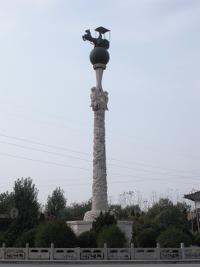
Confucius on his chariot on a globe representing China or the World. Below are 2 dragons.
The Confucius-related sights in Qufu were three (these were also the UNESCO-listed sights): the Cemetery (Forest), the Temple and the Mansion. First I headed to the Cemetery - but not before my driver foisted a guide on me, after helping me knock the price down from 150¥ to 120¥ (at first I suspected they knew each other, but she seemed to think he was a tourist too, so they didn't); another disadvantage of solo travel is you cannot split guide and driver fees.
Credit cards are accepted in few places in China. So my money went quickly - on top of the driver and guide fees, admission for all 3 Confucius sights cost 150¥
While a guide does help you understand more about the place (less if there're language issues - even though my driver told her twice to speak slowly as I was from Singapore, and I asked her to repeat herself from time to time), you forgot most of it within a few days anyway (unless you spend a lot of time writing it down and transcribing it, that is). Also there will always be implicit pressure to move on instead of stopping to really admire each attraction. This while the signage (at major sights especially but usually also many not-so-important ones) is very adequate (though of course not quite as scintillating, and without the possibility of asking questions)

Boulevard leading to the Cemetery (Forest)

Gate of Boulevard
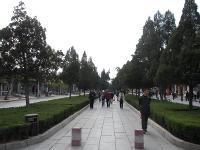
Tree-lined path

Confucius is not the only one beloved in this town

Entrance to the Forest. The Qing Emperor Yongzheng (my notes say 'Yongling' but there is no such emperor) renovated and wrote on this Ming gate.
I was then strongly persuaded by my guide to buy a ticket for the cart that took a route around the Forest. I suspect this was because she didn't want to walk the 7.5km route.
The cart was alright, except that it only paused twice (for guides to give commentary) and made but one stop (upon which all passengers had to disembark and could not get back on). It thus didn't allow visitors to get off at their leisure to explore parts of the forest and reboard when they were ready to move on. My guide told me (and I noticed) that the Chinese don't take photos in cemeteries - this is probably because they feel it's creepy to pose for pictures in there, so there's no point taking -any- photos.
Trees in Confucius Forest
There are no snakes or crows in the Confucius Forest. Snakes are driven away by the herbs in the soil, and the crows by the smell of the trees.
There are 5 types of people who cannot be buried in the Confucius Forest-Cemetery:
1) Women
2) Something I missed (I think it's aborted fetuses)
3) Those under 18 (?)
4) Monks
5) Criminals
Trees and mounds in Confucius Forest
As you can see, the trees are growing very well. Dead bodies are a great soil supplement.
The Cemetery is, I was told, the oldest and most well preserved etc family cemetery in the world. There are 630,000 people buried in the Cemetery - 1/5 of all the people who have been surnamed "Kong".

Only unvandalised grave
This is the tombstone of a 64th Generation Descendant of Confucius. He wrote The Peach Blossom Fan, and his tomb is the most undamaged of all those in the cemetery - because there is no "Kong" word on it, so the Red Guards didn't touch it.



Grave of the Daughter of the Qianlong Emperor. He visited Qufu 9 times - ostensibly to pay his respects to Confucius, but really to visit her. The cart only paused her, instead of stopping.

Trees and mounds



Zhu River bridge - the front says 'Qing' but the back says 'Ming' (the Qing just scrawled their stuff over the old material) - because the Emperor didn't walk back by this way.



Tomb gate



"The Passageway to the Confucius' Tomb"

Qi3 Ling2 ("麒麟", I think). This was an Ancient Babelfish.


Sacrificial Hall. This only opens on Confucius's birthday.



"The Chinese Pistache Planted by Zi Gong" - it fell in Kangxi's reign
This is missing one stroke, but I didn't catch the story

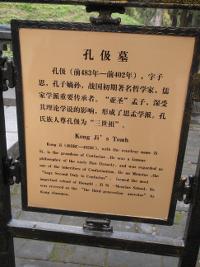
"Kong Ji's tomb" (Confucius's grandson)

Tomb guardian


Kong Li's tomb (Confucius's son)
The tombs of Confucius, his son and his grandson are arranged in a certain meaningful fashion - something about hugging the grandson
Because of Kong Li, they had to rename a fish (because it shared his name).




Confucius's tomb: there's a new large stele (Ming dynasty) obscuring an old, small one (Yuan dynasty). The last character on the large stele is "王" ("King"), but the last stroke was moved down so the Emperor would not see it (so it looks like "干" ["Dry"])

More trees. The stone steles are the tombs of noblemen, and the mounds that of commoners - who can be buried up to 3 layers deep.

"Pork stone". I was tempted to buy one (the small one was 41¥ if I read correctly), but it was a bit steep and totally useless.
For lunch, my driver brought me to a "clean" and "economical" place. This doubtless meant that he got a cut.

What hygiene means in China: shrink-wrapped crockery
The restaurant staff urged me to try their duck. I was reluctant, but it came with free side dishes and I intended to give half of the leftovers that we would doubtless have to my driver; I told him to bring them home for his family (he only had 1-2 pieces) but he refused despite my protesting that I wouldn't be able to finish it, so I was left with more duck than I could finish in one meal - I didn't want to leave any overnight to forestall problems, so I would have to throw some away.
In fact, I couldn't even finish my rice - despite having had only one bing for breakfast; it must be the mountain aftereffect.
Apparently it's the custom to pay for your driver. Oops. No wonder he said "anything" when I asked him what he would like. Luckily the guide didn't come along for lunch.
She also tried to sell me some other dish (tofu I think), but I adamantly refused. As it is the bill already came up to 103¥.

"Confucius Style" Duck with free side dishes (the black one is wild vegetables). There was also soup, which was like slightly murky boiled water with cai xin floating in it, and a bit of mushroom.
My conclusion from eating in Northern China: Cantonese food FTW. There's a reason why the overwhelming majority of Chinese restaurants overseas are Cantonese (no, it's not just because most migrants came from there - why else do we see some Sichuanese and Hunanese restaurants but no Shandongese restaurants)

"肥肥服饰 - 男女加大加肥" ("Fat clothing and accessories - men and women become bigger and fatter")
After lunch I took leave of my driver again and rejoined my guide for the Confucius Temple; the Confucius Temple in Beijing was recommended, but I didn't visit it as I knew I would be visiting the Original.
There was a 鲁 (Lu3) County Old City, but my guide said now only a chair remained and it was just to con tourists' money.
Buildings in Qufu cannot be more than 24.8m high - because this is the height of the Confucius Temple building. I think we can thank UNESCO for that.

Qufu plaque


Entrance to Confucius Temple. The yellow gate is wooden (on close inspection it only looks partially wooden) and was built during the Qing - Qianlong wrote the words.

"The Confucian Temple, also called the Temple of the Great Sage, is the place for sacrificing Confucius and praising Confucianism"
Disturbing Confucius Temple plaque. Also, it does not inspire confidence: "In 1961, the Confucian Temple was proclaimed to be the first cultural relics under the protection of government by the State Council" (the Cultural Revolution came along 5 years later). The claim that it is the "earliest temple in China" is also disputed by Falungong (as you would expect).



Bishui Bridge and Hongdao Gate


Chenghua Tablet. It split in 1973 but is otherwise very well preserved. The creature at the bottom is NOT a turtle.



KuiWen Pavilion, "among the best wooden pavilions in china". Being rebuilt in 1191 would also make it one of the oldest wooden buildings in China. There is also no metal in it (I think my guide assured me that there was nothing inside - though from my experience what the guides thought I should see didn't always coincide with what I would like to see).
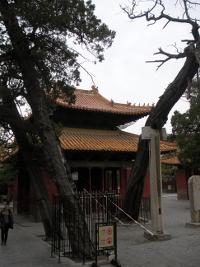
2 trees: the one on the left is a Dragon tree and on the right is a Phoenix one. The right is dead and the left was what Qianlong rested on on his last visit.


The interlocking roofs have some significance for architectural harmony, but I could tell that without my guide (presumably she said something else about it, but I didn't catch it)

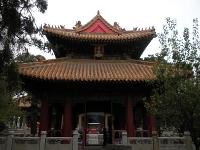

Xingtan pavilion


Ceiling of pavilion
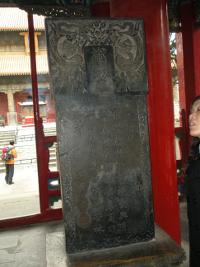
Stele



Da Cheng Palace

Pillar with 2 types of dragons, made of one block of stone


Altar of Da Cheng Palace. The one in the centre should be Confucius, and you find Zengzi, Yanzi, Zisi and Mencius on either side, with some other chaps. Of course the originals were destroyed during the Cultural Revolution, and only replaced in 1983
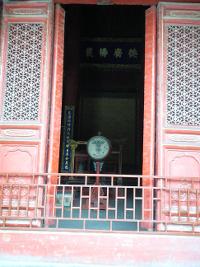
Shang Bells!

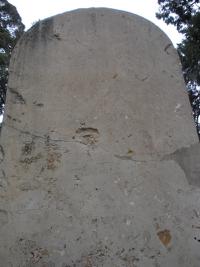

Confucius family tree. I'm quite sure it got vandalised by the Red Guards too.



"Well in old mansion". Confucius well - he was said to drink from it


"lu wall" - the Confucian classics were hidden in this wall when "qinshihuang" went around burning books.
I then exited the temple.